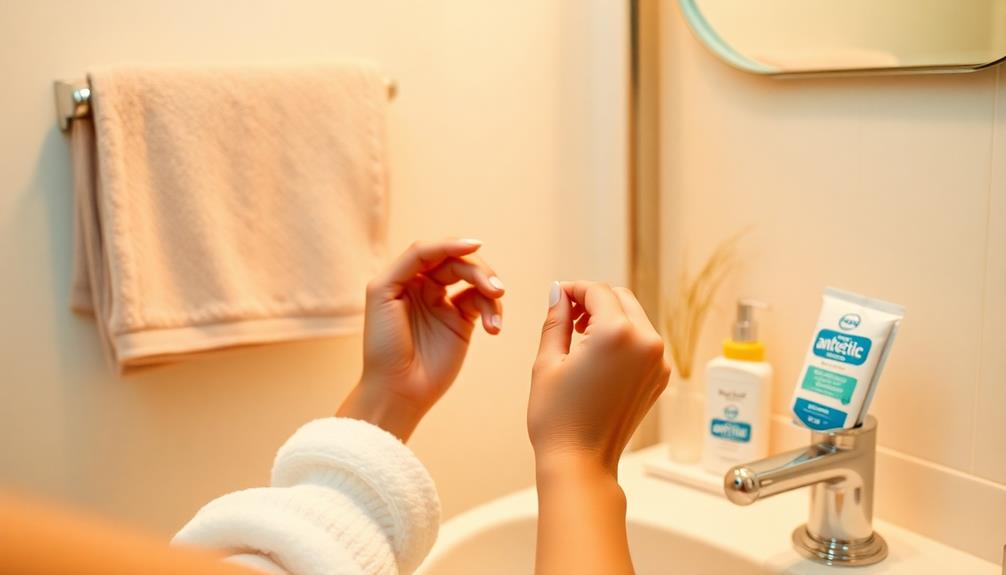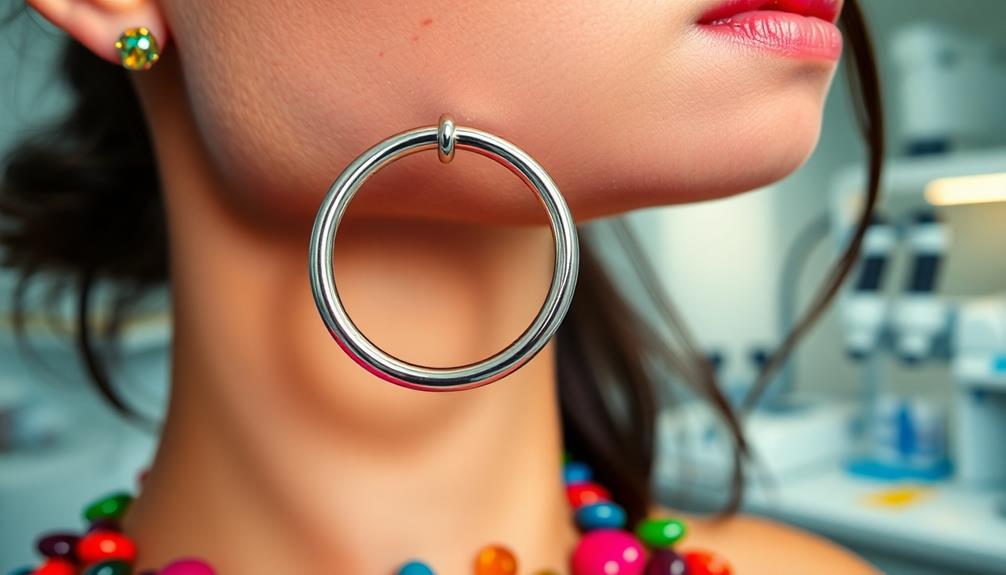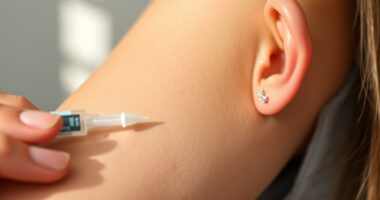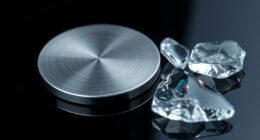If you're pregnant, it's best to avoid new body piercings due to the higher risk of infection during this time. Your immune system is weakened, making it easier for infections to occur. Existing piercings can stay if you keep a close eye on them for irritation and clean them daily. Some piercings, like belly button and nipple ones, may require special care or removal during breastfeeding or surgery. Always consult with a healthcare provider if you notice any signs of infection. Stay informed to keep yourself and your baby safe through your pregnancy journey.
Key Takeaways
- New piercings are strongly discouraged during pregnancy due to increased infection risks and a weakened immune system.
- Existing piercings can remain but should be monitored for irritation and cleaned daily.
- Belly button and nipple piercings may require jewelry adjustments; remove them for C-sections and before breastfeeding.
- High-quality, hypoallergenic jewelry is essential to minimize infection risks; consult professionals for safe options.
- Alternatives like temporary body art and non-invasive beauty treatments are safer ways to express personal style during pregnancy.
Piercing Safety During Pregnancy

When it comes to piercing safety during pregnancy, it's best to tread carefully. New piercings are generally discouraged due to the increased risk of infection and a weakened immune system that can threaten both you and your baby.
If you already have existing piercings, you can typically keep them as long as you monitor for any irritation and clean them daily with soap and water.
Belly button piercings can become uncomfortable as your pregnancy progresses. Consider using flexible jewelry, like Teflon, which can better accommodate your body's changes.
If you have nipple piercings, it's essential to remove them before breastfeeding to avoid complications such as infections or choking hazards for your baby.
Always consult your healthcare provider if you notice any signs of infection or irritation related to your piercings. They can give you tailored advice to keep both you and your baby protected.
Keeping an open line of communication with your healthcare provider will help you manage any concerns about your piercings throughout your pregnancy. Being proactive about your piercing safety can help guarantee a smoother experience during this special time.
Types of Piercings and Risks

Body piercings come in various types, each with unique risks, especially during pregnancy. New piercings, particularly in sensitive areas like the belly button or nipples, are strongly discouraged due to increased infection risks and complications from your body's changes.
If you're considering a belly ring, remember that while it generally doesn't affect vaginal births, it may need to be removed for C-section deliveries to prevent surgical complications.
Existing piercings, on the other hand, can usually stay in place, but you might experience discomfort as your body expands. This is where flexible jewelry, like polytetrafluoroethylene, can be beneficial, helping accommodate growth without causing irritation.
Facial piercings, such as those in the nose or cartilage, also pose infection risks and may complicate medical procedures, so it's wise to postpone these until after pregnancy.
Similarly, ear piercings are best left until later. Nipple piercings can be particularly problematic during breastfeeding, presenting choking hazards for your baby and higher chances of infection.
Removing them before lactation begins is advisable for your health and safety.
Infection Risks and Care

Infections are a significant concern for anyone with body piercings, and this risk escalates during pregnancy due to a weakened immune system. When you're pregnant, your body's defenses are lower, making it easier for infections to take hold, especially from unhealed or improperly cared-for piercings.
The emotional toll and heightened sensitivity during pregnancy can also amplify concerns about body image, which might lead to impulsive decisions regarding piercings, as noted in studies about emotional dysregulation in various circumstances, including emotional stability during divorce. The infection risks include serious hazards to your fetus, particularly if you contract bloodborne diseases like hepatitis or HIV.
It's important to monitor your piercings regularly for signs of infection, such as redness, swelling, or discharge. These symptoms can escalate quickly during pregnancy, so don't ignore them. Proper aftercare is essential; make sure you clean your piercings daily with soap and water to help prevent infections and protect both your health and your baby's.
If you notice any signs of irritation or infection, consult your healthcare provider immediately. Early intervention can prevent complications that might affect your pregnancy.
Jewelry Considerations

Choosing the right jewelry during pregnancy is vital for your comfort and safety. Opt for high-quality, hypoallergenic, and nickel-free jewelry to minimize the risk of allergic reactions and infections in your existing piercings. This is particularly important as your body undergoes numerous changes throughout pregnancy.
For belly button piercings, consider using flexible materials like polytetrafluoroethylene (PTFE). This type of jewelry allows for movement and can accommodate your expanding belly, reducing discomfort.
It's best to avoid new piercings in sensitive areas, such as the belly, nipples, and genitals, due to increased risks associated with hormonal shifts and physical changes.
Regularly monitor your existing jewelry for any signs of irritation or infection. If you notice any issues, especially in high-movement areas, you may need to remove the jewelry.
Always prioritize proper aftercare to maintain cleanliness and prevent complications.
Lastly, consulting with a professional piercer is essential. They can guide you toward safe jewelry options and appropriate aftercare practices, ensuring that your experience during pregnancy remains healthy for both you and your baby.
Communication With Piercers

When you're pregnant, clear communication with your piercer is important for maintaining your health and safety.
It's necessary to inform your piercer about your pregnancy status, as this allows them to provide tailored advice on how to care for your existing piercings. Open communication helps you discuss any changes or discomfort you may experience, guaranteeing you receive the appropriate guidance for your situation.
Your piercer can recommend specific types of jewelry, like polytetrafluoroethylene options, which might be more comfortable and safer during pregnancy. They can also offer strategies to prevent pulling or tearing of the jewelry, especially as your body undergoes changes.
Most importantly, keeping your piercer informed about your pregnancy allows them to advise you on proper aftercare and hygiene practices. This is critical for minimizing the risk of infection, a concern that can affect both you and your baby.
To summarize, don't hesitate to reach out to your piercer with any questions or concerns. Their expertise can help make sure that your piercings remain safe and comfortable throughout your pregnancy.
Professional Standards for Piercing
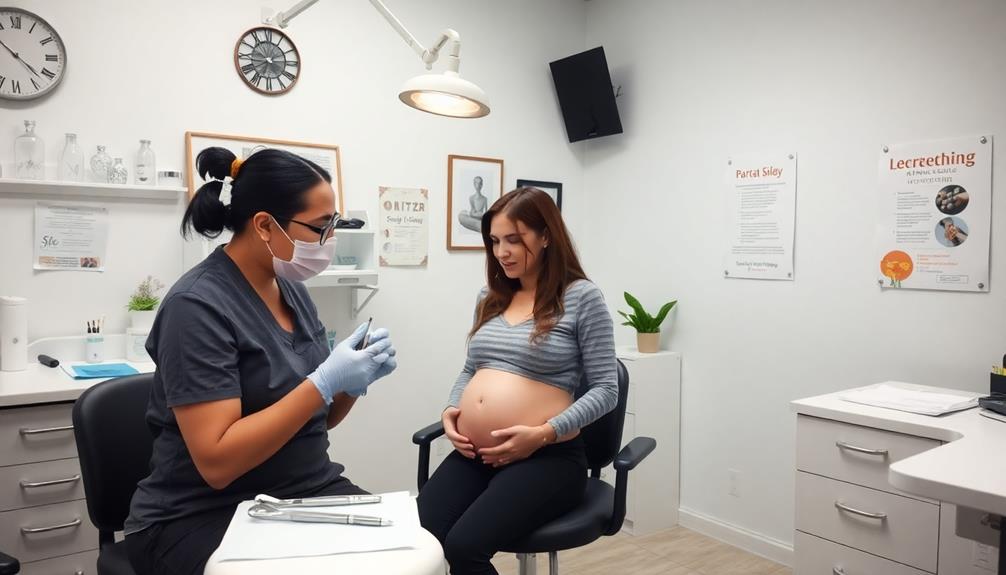
When you're considering a body piercing, it's essential to guarantee that the studio meets health regulations and professional standards.
A licensed piercer should always use sterile equipment and follow strict safety practices to protect your health.
Knowing these standards can help you make informed choices and feel confident in your piercing experience.
Health Regulation Compliance
In a safe and professional piercing environment, compliance with health regulations is essential for protecting both clients and practitioners.
For expectant parents considering body piercings, understanding these standards can alleviate concerns about safety.
Here are key regulations you should know:
- State Registration: Piercing studios must be registered and adhere to local health regulations.
- Sterile Gloves: Each piercing procedure requires the use of new sterile gloves to minimize infection risk.
- Autoclave Sterilization: An autoclave sterilization unit is vital for disinfecting all equipment used in the process.
- Clean Environment: All surfaces and floors within the studio must be kept clean and sterilized to prevent bacteria spread.
Sterilization and Safety Practices
Guaranteeing your safety during a body piercing procedure hinges on the studio's adherence to sterilization and safety practices. Professional piercing studios must be state-registered and comply with health regulations to protect you during the process.
Each procedure requires the use of new sterile gloves, and all equipment must be sanitized using an autoclave sterilization unit to prevent infections.
To minimize contamination risks, only single-use, disposable needles should be used for your piercing, along with sterile-packed dressings. This assures that everything involved is clean and safe for your body.
Additionally, the surfaces and floors in the piercing studio should be regularly cleaned and sterilized, maintaining a hygienic environment.
It's essential for you to inquire about the studio's sterilization practices and the materials used in body jewelry. This not only guarantees safety but also helps reduce the risk of allergic reactions or infections that could endanger your health or the health of your baby.
Licensed Professional Experience
Choosing a licensed professional piercer is essential for a safe and satisfying piercing experience. When seeking a professional, consider these key factors:
- Regulations: Licensed professional piercers follow state regulations and health guidelines.
- Sanitation: They use new sterile gloves and sanitize equipment with autoclave sterilization.
- Safe Practices: Professionals are knowledgeable about high-quality, hypoallergenic jewelry to minimize allergic reactions.
- Aftercare Instructions: Clear communication about aftercare instructions and potential risks is a must, especially for pregnant individuals.
By opting for a licensed piercer, you guarantee that the procedure is performed in a clean environment, reducing the risk of infection.
They'll maintain clean surfaces and use single-use, disposable needles, keeping your safety a top priority.
Additionally, they'll explain the importance of aftercare to help you navigate any challenges post-piercing.
Alternatives to Body Modifications

Exploring alternatives to body modifications during pregnancy opens up a world of creative expression without the risks associated with traditional methods.
Temporary body art, like henna or body paint, offers a vibrant way to express yourself while avoiding needles and inks. Aromatherapy can also be a wonderful addition to your self-care routine, promoting relaxation and emotional well-being through pleasant scents aromatherapy benefits.
If you're interested in accessorizing, clip-on jewelry is a fantastic, non-invasive option that allows you to showcase your style without the commitment of piercings.
You can also turn to non-invasive beauty treatments, such as facials or massages, which provide relaxation and enjoyment during this unique time. For even more fun, consider safer non-permanent methods like skin-safe stickers or temporary tattoos, allowing you to change your look with ease.
Engaging in self-care practices can greatly enhance your well-being. Building a skincare routine or indulging in a pampering session helps you feel good without needing body modifications.
All these options not only promote personal expression but also support your health during pregnancy. Embracing these alternatives can be a fulfilling way to celebrate your journey without the potential complications that come with traditional body modifications.
Frequently Asked Questions
Can Pregnancy Affect Existing Piercings?
Yes, pregnancy can affect existing piercings. You might experience increased sensitivity and discomfort due to hormonal changes. Regularly check for irritation, and consider flexible jewelry to guarantee comfort as your body expands.
Can You Have Back Piercing While Pregnant?
You can keep your back piercing during pregnancy if it's healed, but be cautious. Your body changes might cause discomfort. Always monitor for irritation, and consult your healthcare provider if any issues arise. Your comfort matters!
What Happens if You Get a Belly Piercing While Pregnant?
If you get a belly piercing while pregnant, you risk infection and complications. Your immune system's weaker, and your belly's expanding can lead to discomfort or irritation. It's best to avoid new piercings during this time.
Can You Wear Earrings While Pregnant?
Wearing earrings during pregnancy can feel like adorning yourself with tiny treasures. You can wear them, but keep an eye out for irritation. Prioritize hygiene and choose hypoallergenic options to keep discomfort at bay.
Conclusion
In the delicate dance of pregnancy, it's wise to tread carefully when it comes to body piercings. Just as you nurture new life, you must protect your body from potential risks. By choosing wisely, communicating openly with your piercer, and prioritizing hygiene, you can navigate this journey with confidence. Remember, your body's a temple, and during this sacred time, it's best to adorn it with caution and care. Embrace the beauty of this phase, piercings or not!


